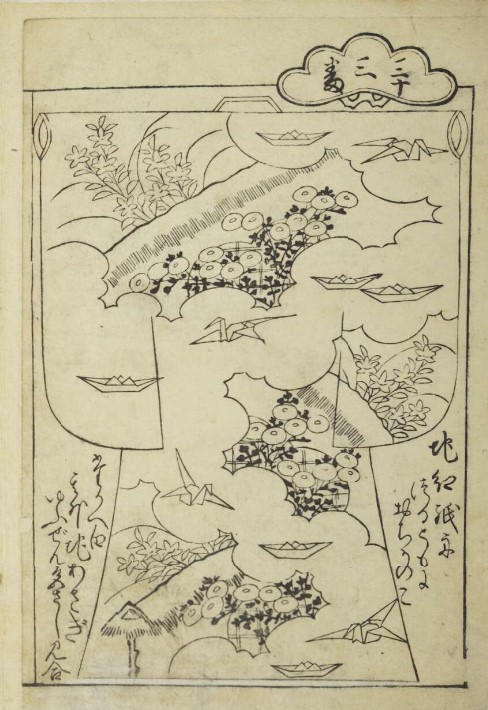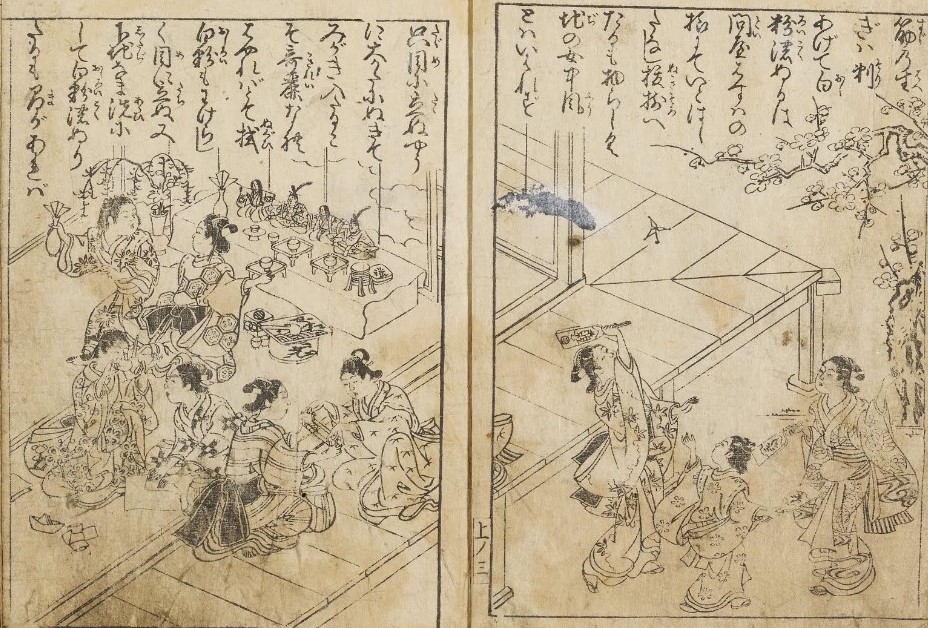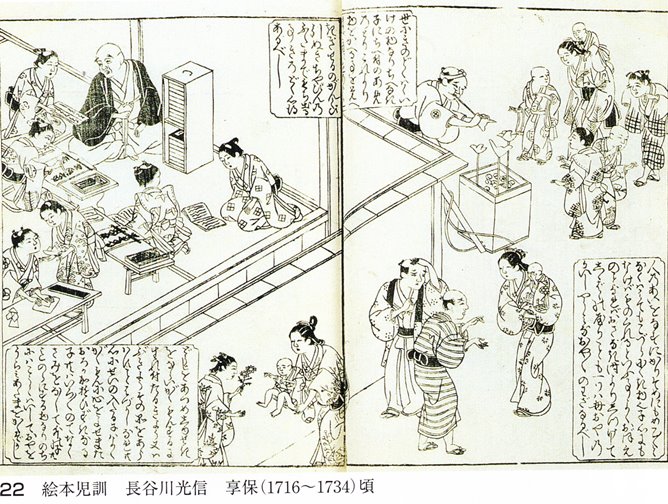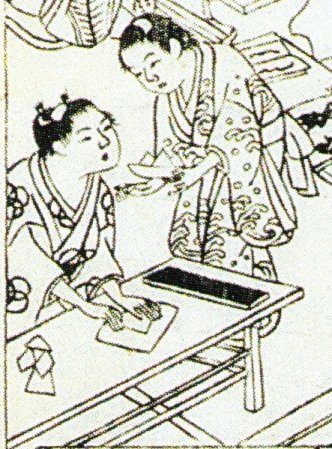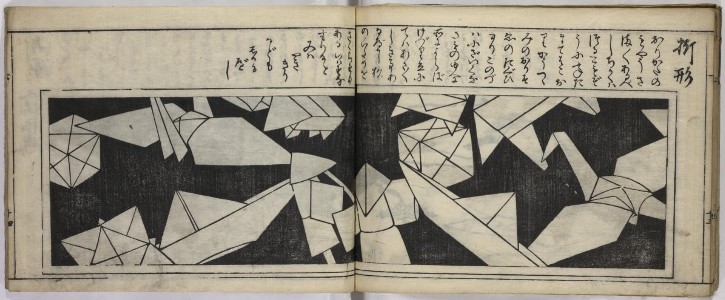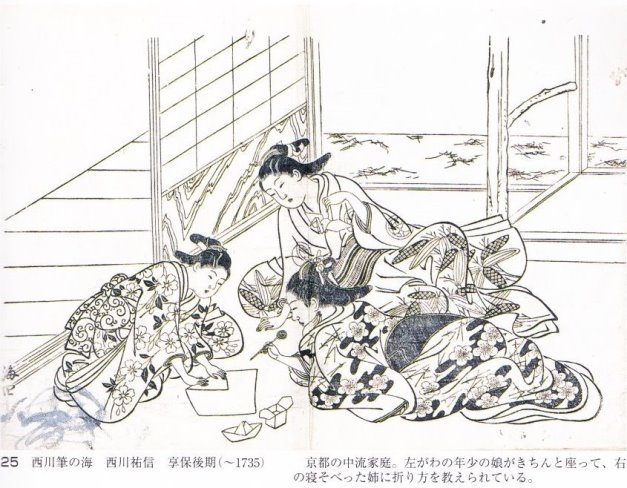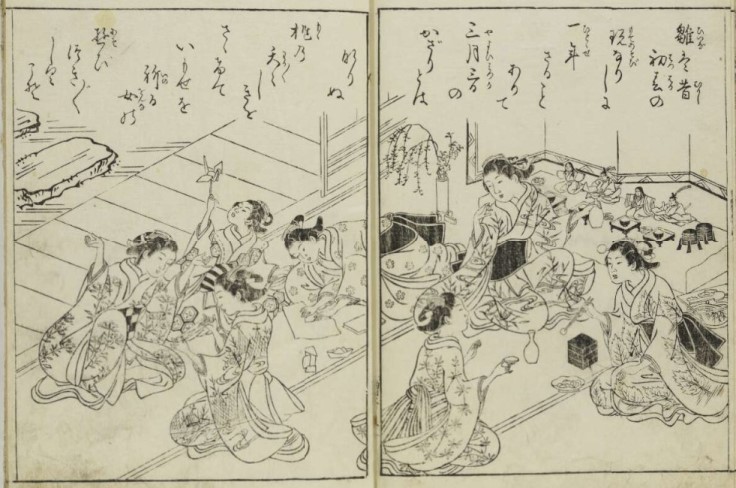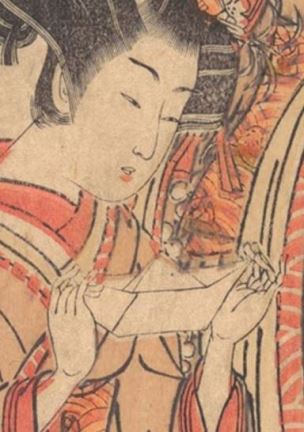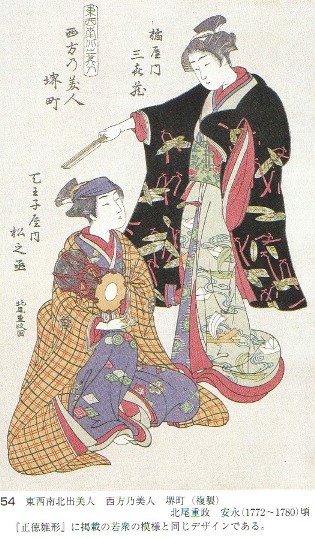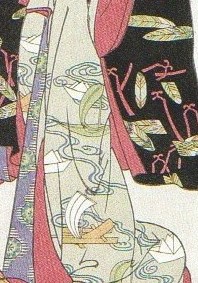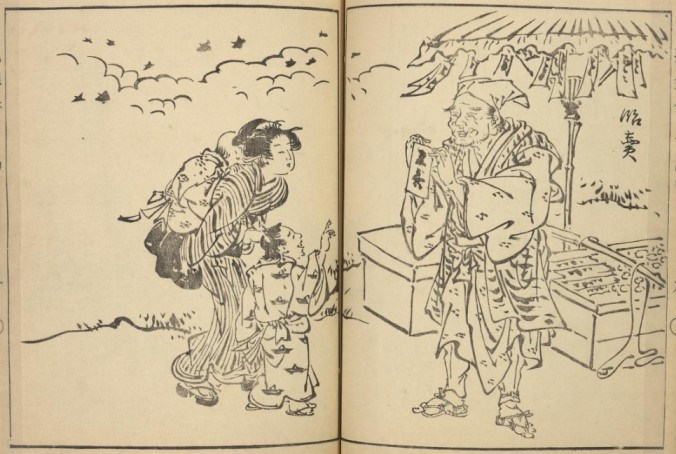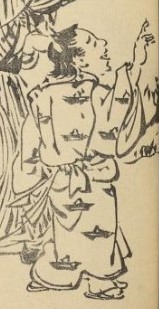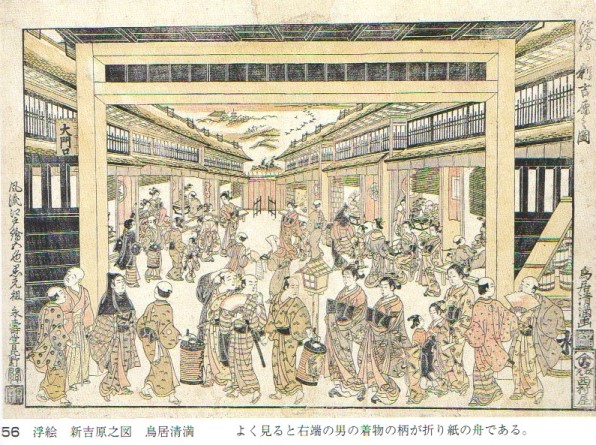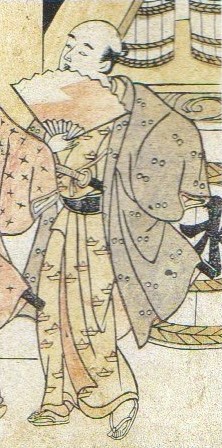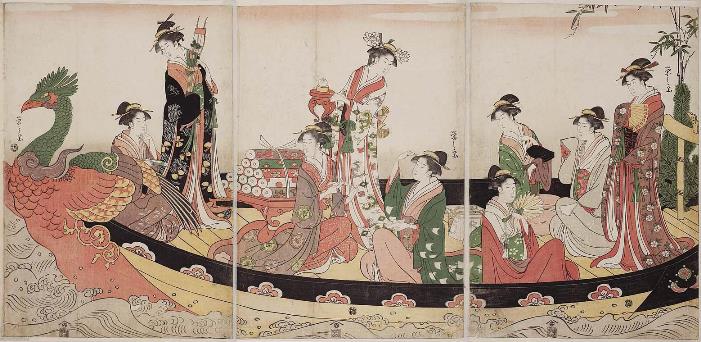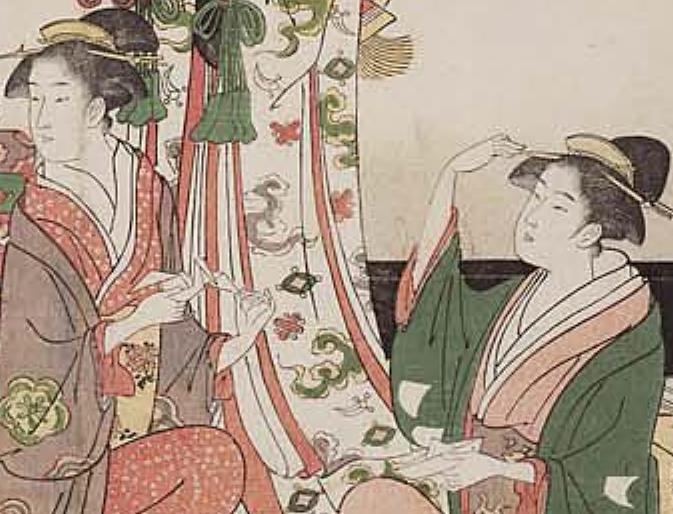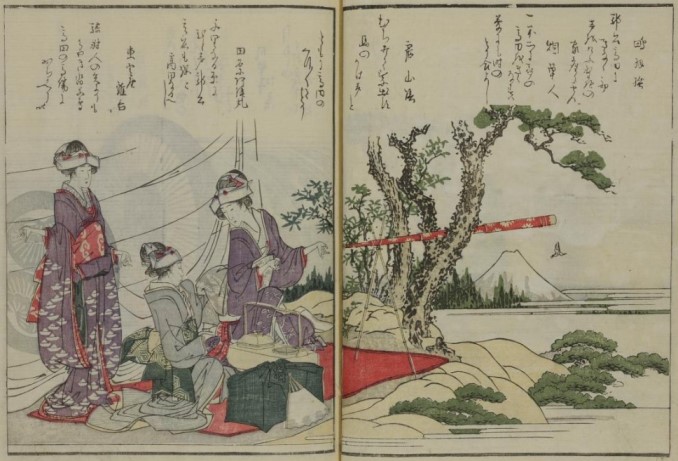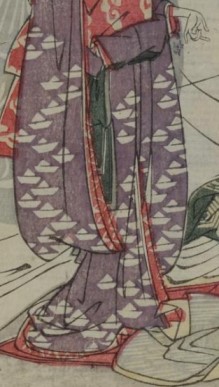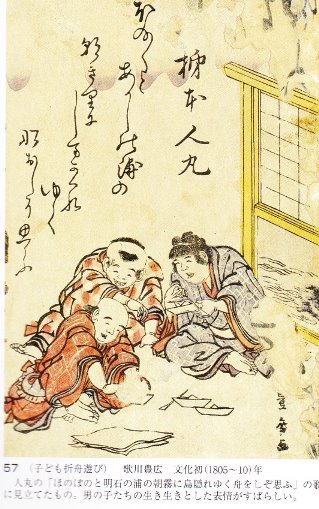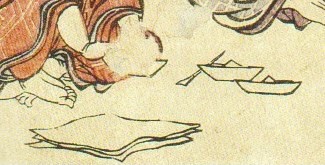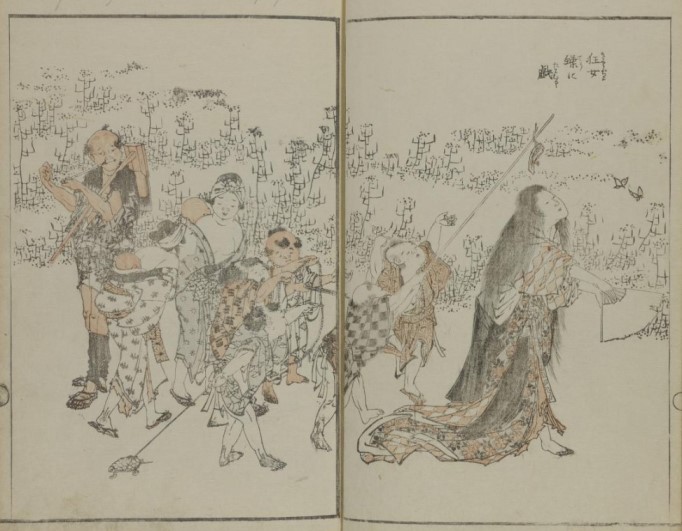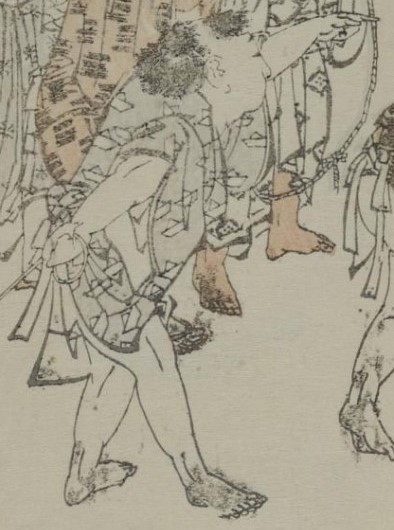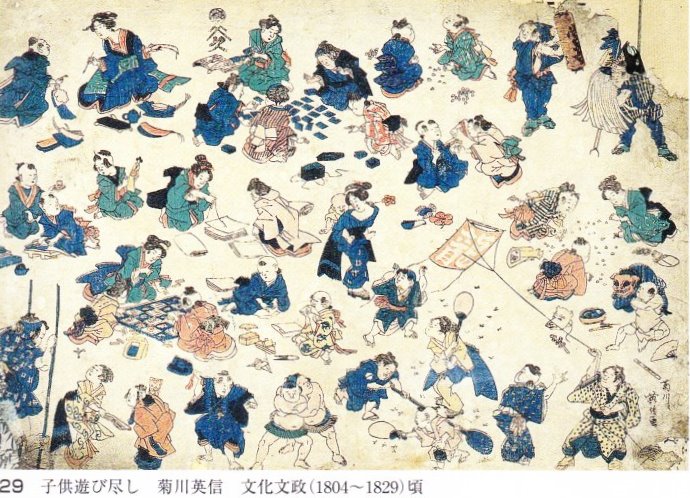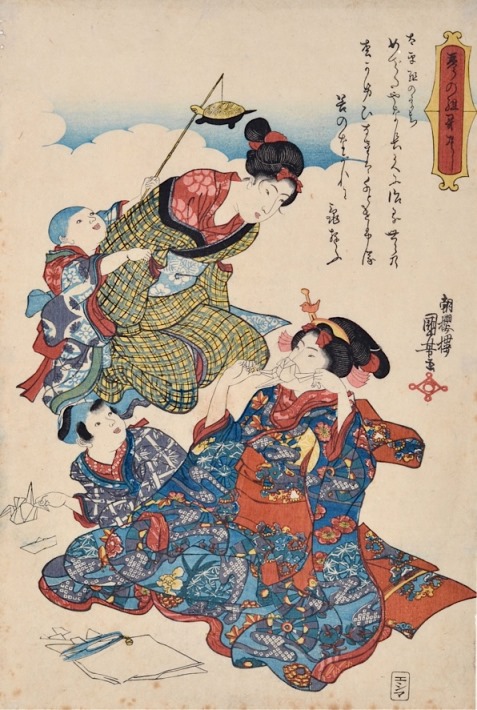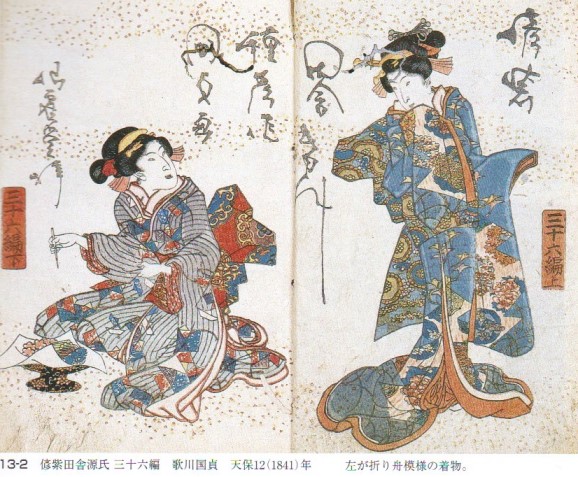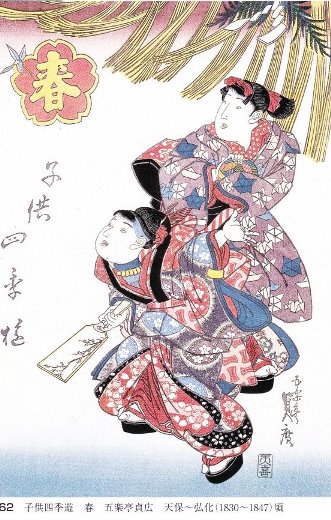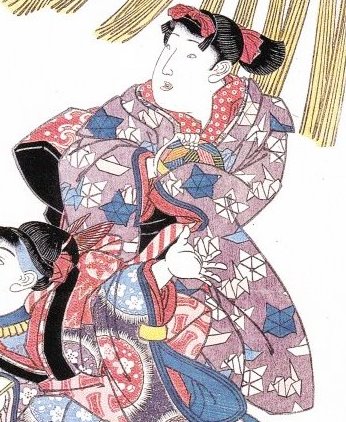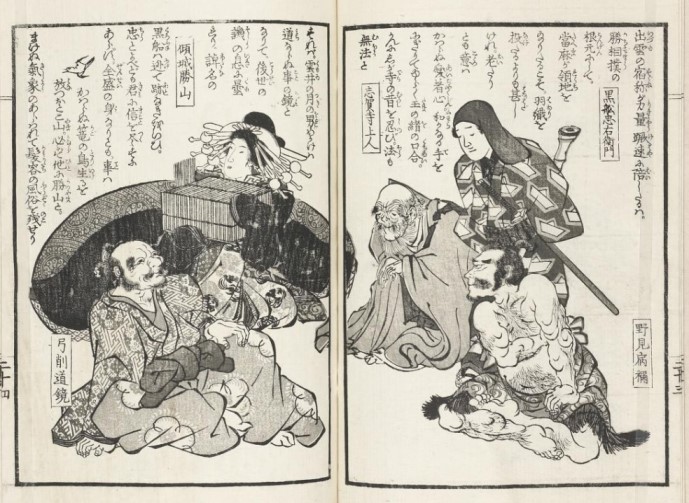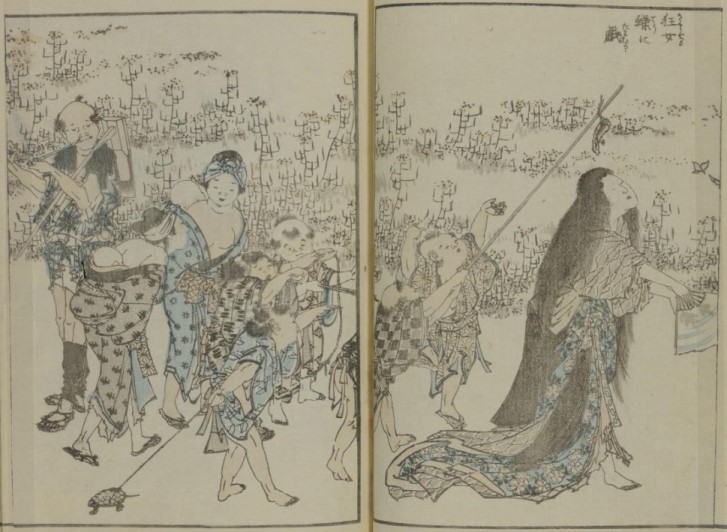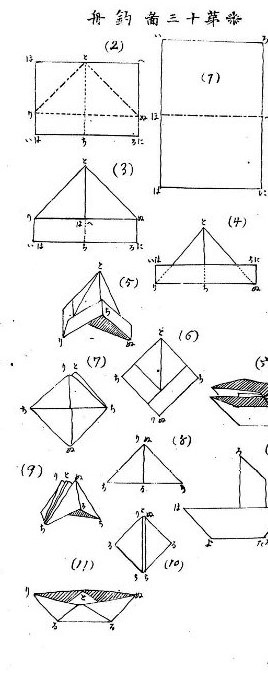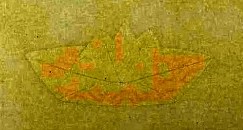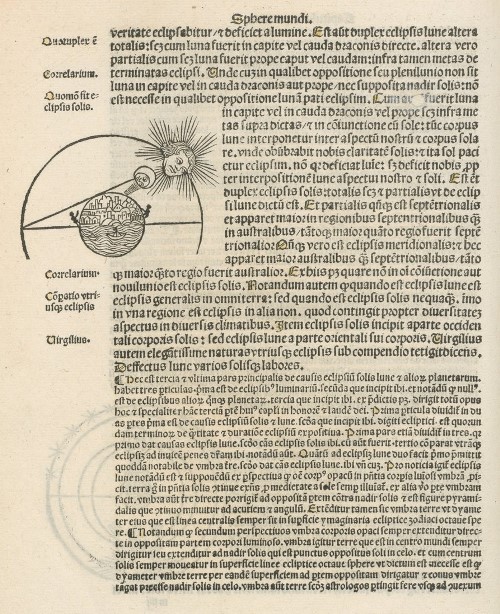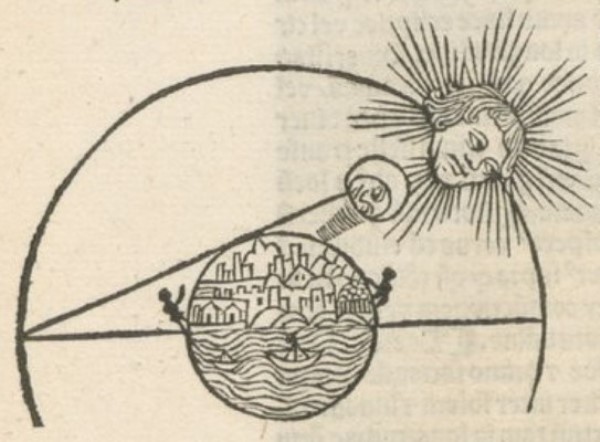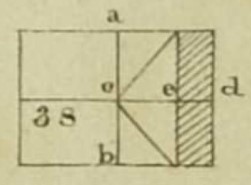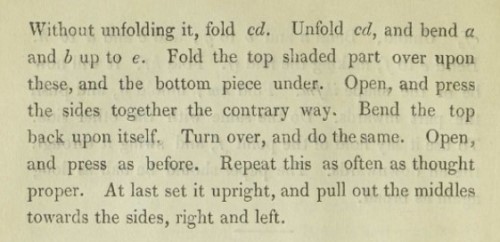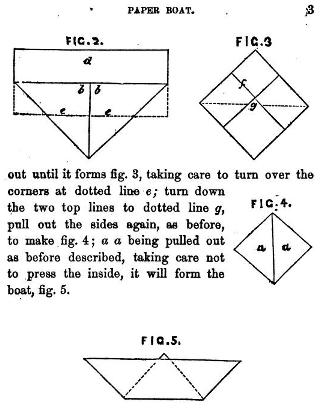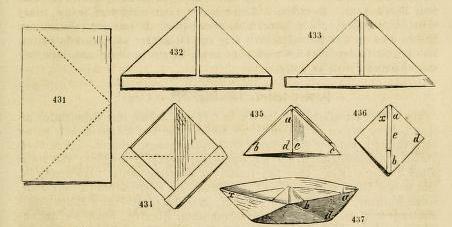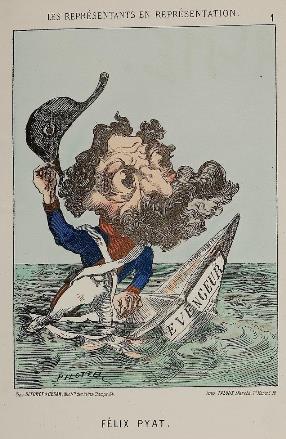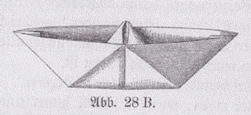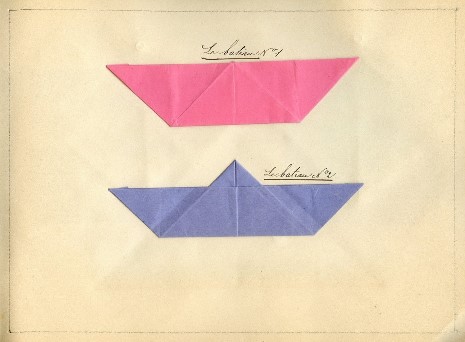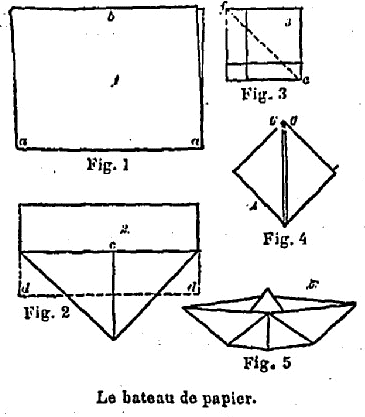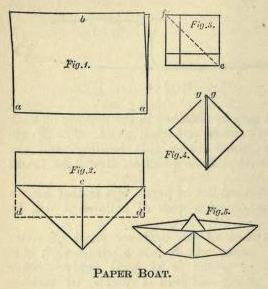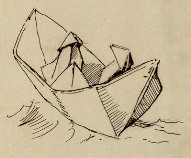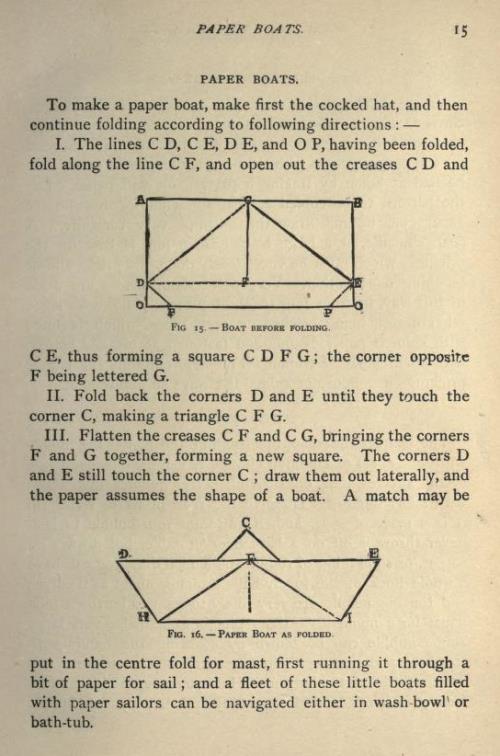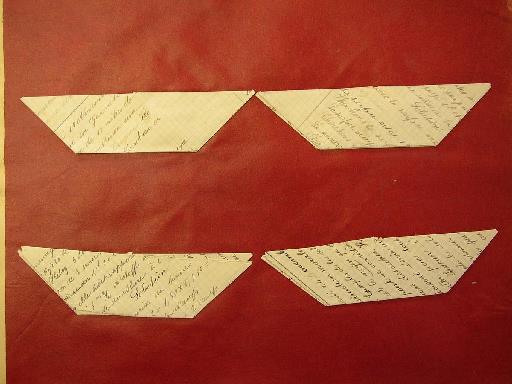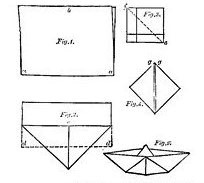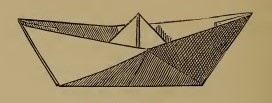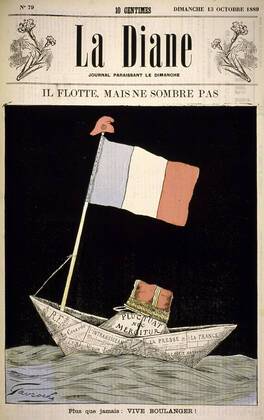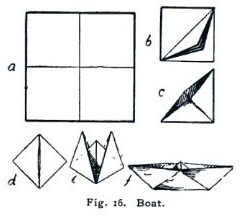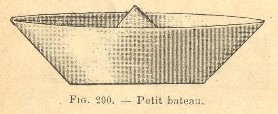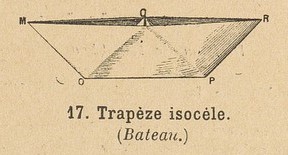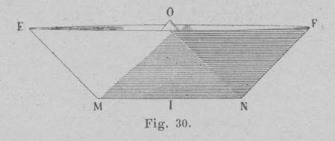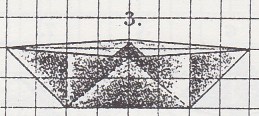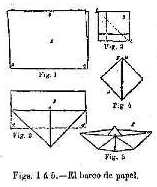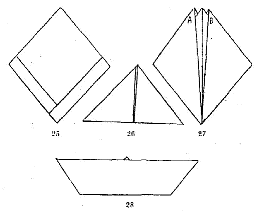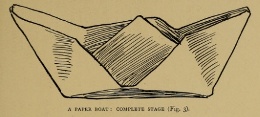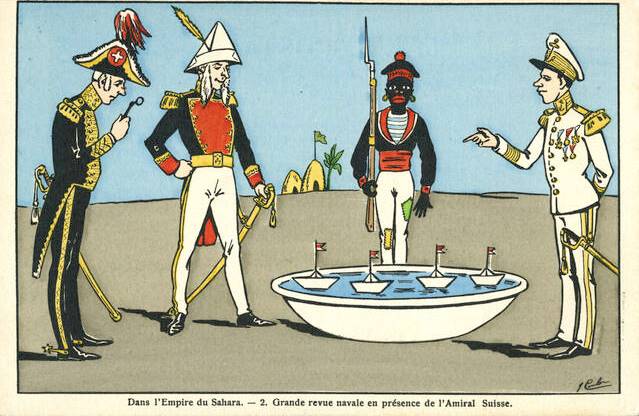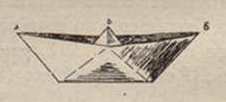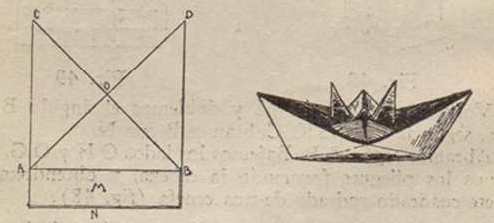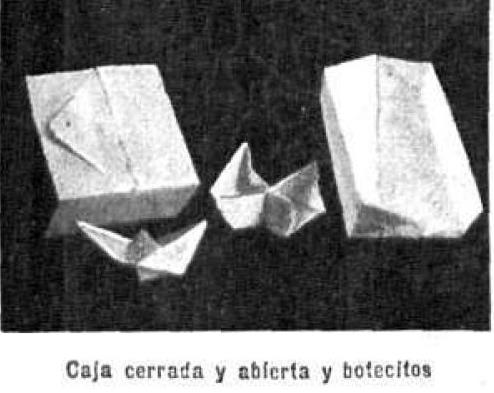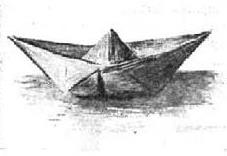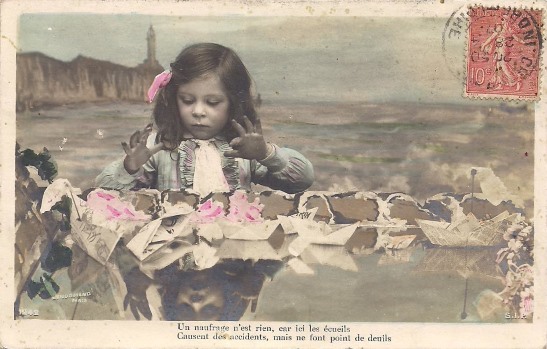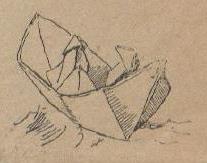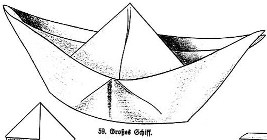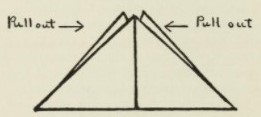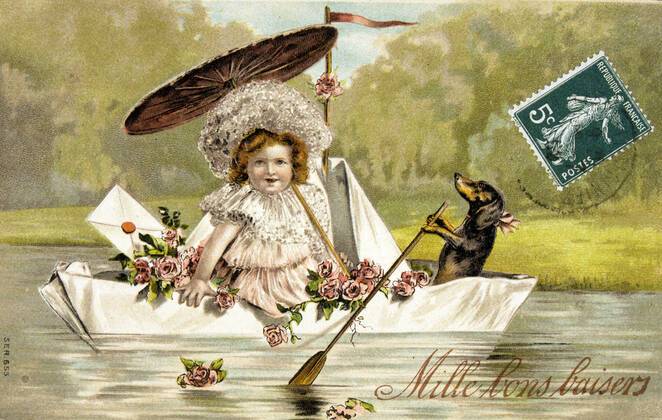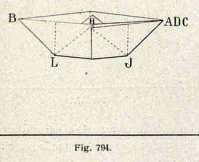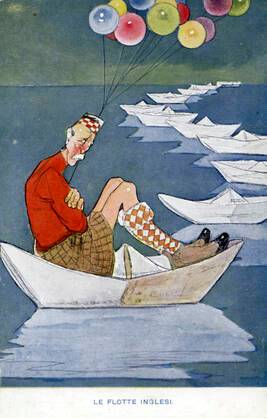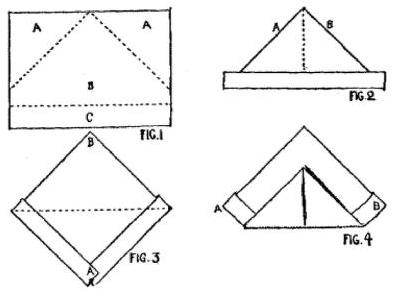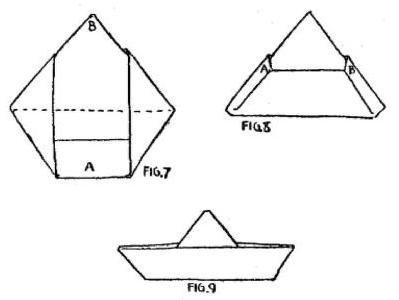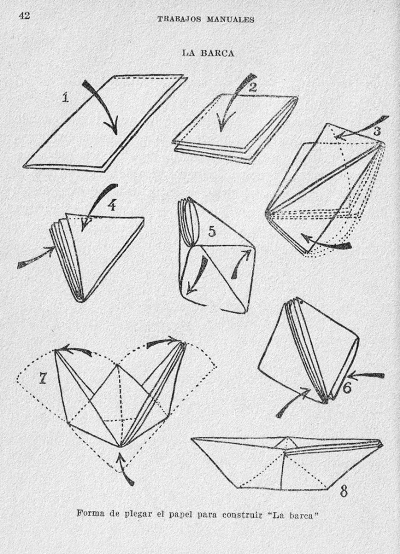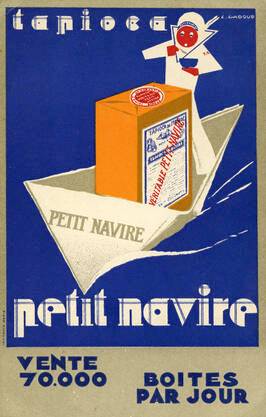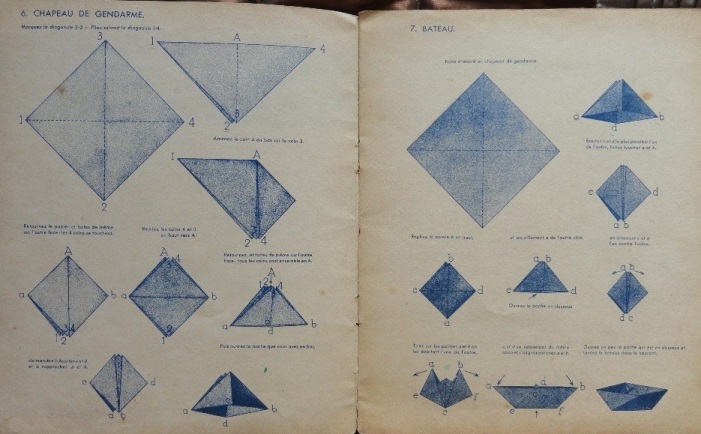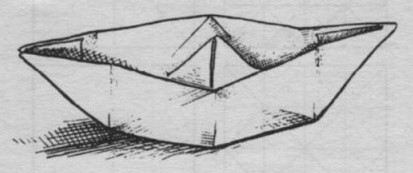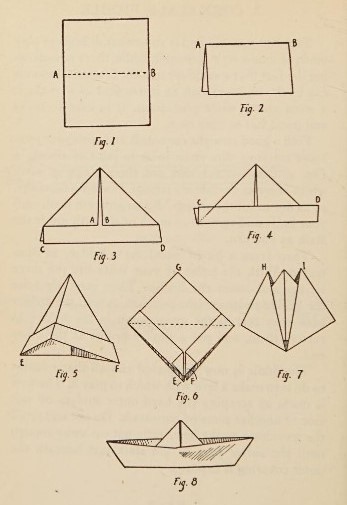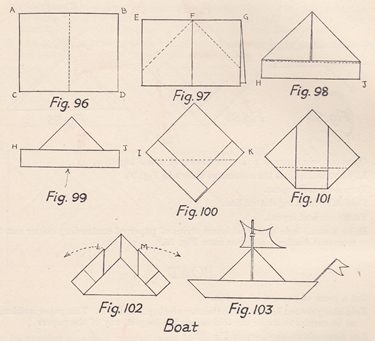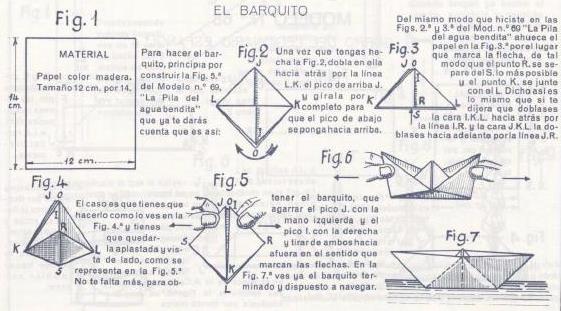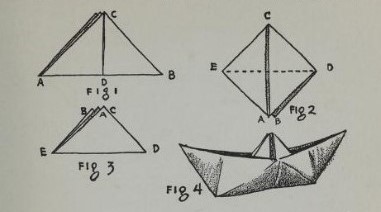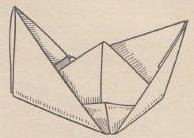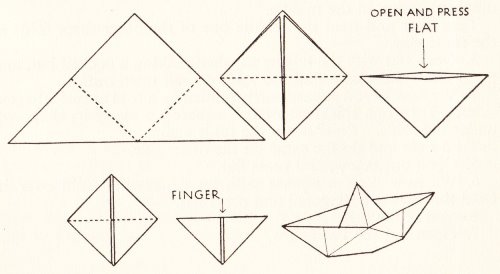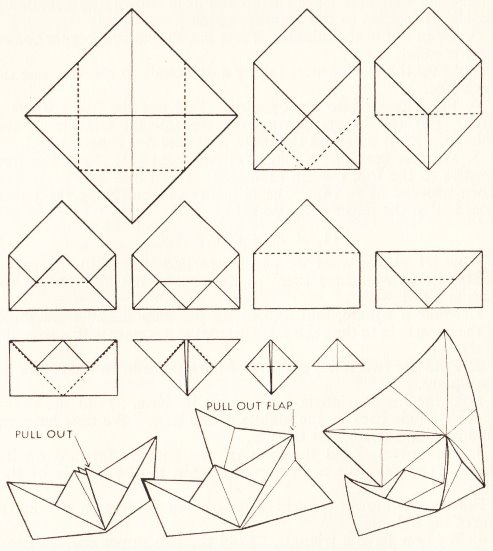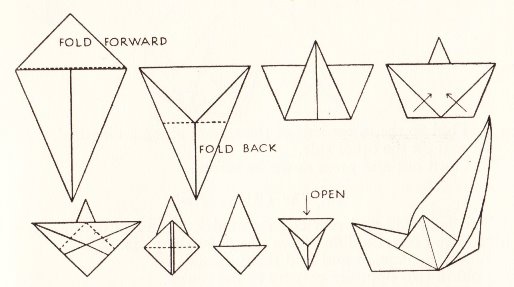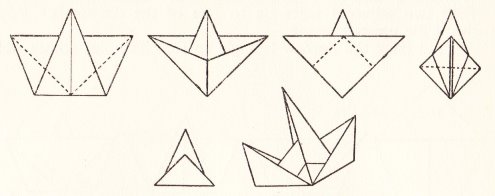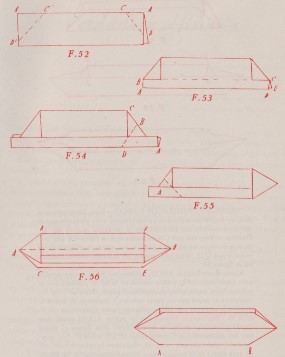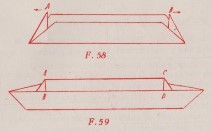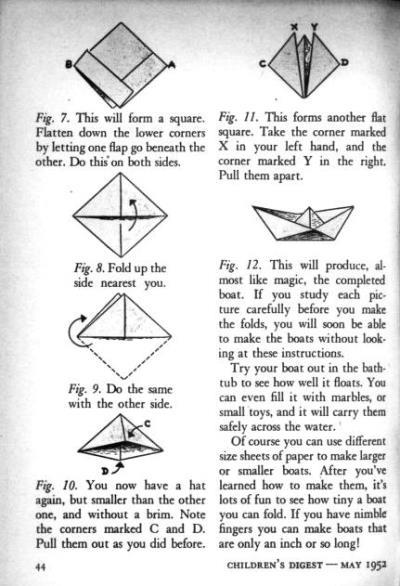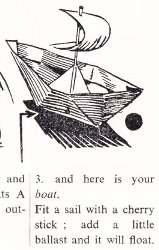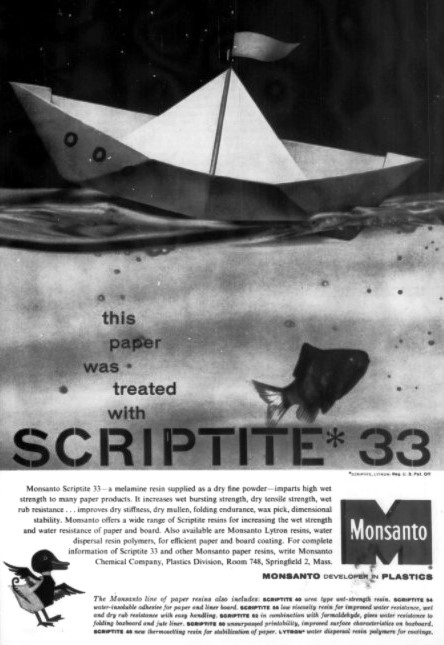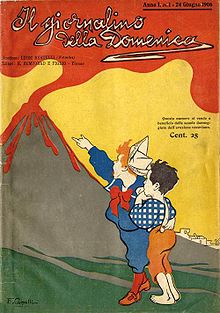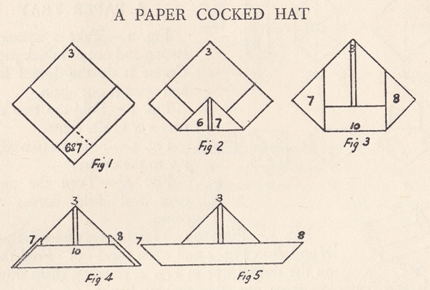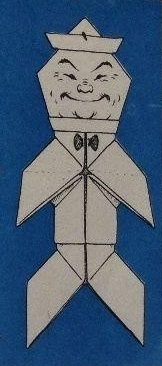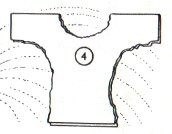| The Public Paperfolding History Project
Last updated 30/4/2024 x |
|||||||
| The Paper Boat / Paper Boat with Three Sails / The Paper Boat Hat / The Captain's Shirt | |||||||
| This
page is being used to collect information about the
history of the paperfolding design usually known as The
Paper Boat and of the Paper Boat Hat (which is simply the
same design used as a hat). Please contact me if you know
any of this information is incorrect or if you have any
other information that should be added. Thank you. Both Paper Boats folded from oblongs and Paper Boats folded from squares are recorded on this page. Information about early mentions of paper boats that are not accompanied by illustrations or cannot otherwise be positively identified as the Paper Boat design is recorded on the Paper Boats and Paper Ships page. There is a separate page for the derivative design known as The Paper Boat Snapper. ********** The Paper Boat / The Paper Boat with Three Sails Introduction This design was known in both Western Europe and Japan at an early date. The Western European design, which has one central point or sail, was usually folded from an oblong (although occasionally from a square). There appear to be two (or possibly three) different Japanese designs, both / all of which are included on this page. One of these is similar to the European design. The other has three central points or sails and so can be called the Paper Boat with Three Sails. Two different versions of this design can be distinguished but it is possible that they are different representations of the same design. Both versions of the Paper Boat with Three Sails (if there were two versions) were probably (although not certainly) folded from squares rather than oblongs. The Utagawa Toyohiro print from 1805/10 certainly shows square paper being used. The Western European version of the Paper Boat is the basis of the now well-known story of the Captain's Shirt where both ends of the boat and the top of the sail are torn away at various stages in a story about a shipwreck and the remainder unfolded to show that the paper is now in the form of a rather tattered shirt. This story is often associated with Lillian Oppenheimer (1898 - 1992) but I do not know whether she invented it, and if she did, when that invention took place. ********** In Japan (and in books by Japanese authors) 1713 The print below is said to come from 'Shotoku Hinagata' (aka Shotoku 3) by Nishikawa Sukenobu, a kosode pattern book which was published in 1713. It shows two types of model boat, one made largely of wood and the other a version of the Paper Boat. This is not the version folded from an oblong with which Western children are familiar but a similar design folded from a square which has two extra 45 degree points (perhaps sails) in the centre of the boat. Source: 'Oru Kokoro', the catalogue of an exhibition on paperfolding history held in Tatsuno City History and Culture Museum in 1999. It does not however appear in the version of 'Shôtoku hinagata' held in the Boston Museum of Fine Arts.
********** 1716 This design featuring Paper Boats comes from the pattern book '(Chinshoku) Hinagata Miyako fuzoku' (Rare and Popular Kimono Patterns of the Capital) by Nishikawa Sukenobu, which was published in 1716.
********** 1723 This print showing a Paper Boat lying on the floor comes from 'Onna Fuhzoku Tama kagami' by Nishikawa Sukenobu, which was published in 1723.
********** 1734 This print from a picture book by Mitsonubo Hasegawa, which can be dated to between 1716 and 1734, shows two children with a Komoso and a Paper Boat with Three Sails in a terakoya (a school for the children of commoners). Source: 'Oru Kokoro', the catalogue of an exhibition on paperfolding history held in Tatsuno City History and Culture Museum in 1999.
********** 'Ranma Zushiki', a Japanese book of woodcuts published in 1734, contains a print that shows a group of folded paper objects, among which are two Paper Boats.
********** 1735 This print by Nishikawa Sukenobu is sourced from the catalogue of an exhibition on paperfolding history held in Tatsuno City History and Culture Museum in 1999. The girl at the back is holding a Paper Crane. A Paper Boat and a Sanbo are lying on the floor.
********** 1748 The print below is from the first volume of the illustrated book 'Ehon masu kagami' by Nishikawa Sukenobu, which was published in 1748. The subject of the print is the Hina Doll Festival and the ladies on the left are folding paper. There is a Paper Boat lying on the floor. Compare and contrast the similar print from 1723 above. There are a number of other similar prints which also show Paper Boats, but which I have not yet managed to verify or date. Details of these can be found on the page about Paperfolding in Prints by Nishikawa Sukenobu.
********** 1775 This print by Isoda Koryusai (1764-1788) showing a Paper Boat can be dated to around 1775 (Information from Juan Gimeno).
********** 1772 - 1780 This print by Kitao Shigemasa (1739 - 1820) shows a kimono patterned with Paper Boats. Source: 'Oru Kokoro', the catalogue of an exhibition on paperfolding history held in Tatsuno City History and Culture Museum in 1999. This kimono design has obvious similarities to the design from 'Skotoku Hinagata' aka Shotoku 3 by Nishikawa Sukenobu, published in 1713 (see above).
********** 1781 This print by Isoda Koryusai (1735 to1790), which shows a child wearing a kimono decorated with Paper Boats, comes from vol 2 of the illustrated book Konzatsu Yamato Soga, which was published in 1781.
********** 1785 This undated print by Torii Kiyomizo (1735 - 1785) shows a man wearing a kimono patterned with Paper Boats. It can be no later than 1785 when Torii Kiyomizo died. Source: 'Oru Kokoro', the catalogue of an exhibition on paperfolding history held in Tatsuno City History and Culture Museum in 1999.
********** 1793 A lady holding a Paper Boat (and another holding a Paper Crane) appears in the central panel of this triptych by Chôbunsai Eishi (1756–1829) titled 'Women in a Phoenix Boat at New Year' which can be dated to c1793. Information from Jaume Coll Guerrero.
********** 1804 This print by Katsushika Hokusai (1760-1849), which shows a woman wearing a kimono patterned with Paper Boats, comes from vol1 of the picture book 'Ehon kyoka yama mata yama' which was published in 1804.
********** 1805 - 1810 This print by Utagawa Toyohiro (1773–1828) shows three boys folding Paper Boats. Source: 'Oru Kokoro', the catalogue of an exhibition on paperfolding history held in Tatsuno City History and Culture Museum in 1999.
********** 1820 This print by Katsushika Hokusai (1760-1849), which shows a child wearing a kimono patterned with Paper Boats, comes from the illustrated book 'Hokusai soga' which was published in 1820.
********** 1804-1829 A print by Eishin Kikugawa (1787 - 1867) showing children playing various games includes two children, a boy and a girl, folding paper. The items threy have already folded are a Paper Crane, an unidentifiable box, a Paper Boat and what looks like a more complex version of the Kabuto or Samurai Helmet. Source: 'Oru Kokoro', the catalogue of an exhibition on paperfolding history held in Tatsuno City History and Culture Museum in 1999.
********** 1840 This print by Utagawa Kuniyoshi, which is said to date from 1840, shows a mother inflating a crane while her child sits beside her holding another. A paper boat lies nearby on the floor. The small pieces of paper lying near the scissors are anachronistic since neither design requires cuts.
********** 1841 This print by Utagawa Kunisada, which can be dated to 1841, shows a child wearing a kimono patterned with Paper Boats. Source: 'Oru Kokoro', the catalogue of an exhibition on paperfolding history held in Tatsuno City History and Culture Museum in 1999.
********** 1845 There is a note in the 'Kan No Mado', usually dated to 1845, which lists a boat among those designs which are already well known and which are therefore not included in the ms (in order to spare the writer's brush). While, in the absence of a drawing, we cannot be completely certain that this note refers to the Paper Boat, it seems overwhelmingly likely that it does so. ********** 1847 This print known as 'Spring' from the children's four seasons series by Gorakutei Sadahiro, which can be dated to between 1830 and 1847, shows a child wearing a kimono which is patterned with Paper Cranes, Paper Boats and Star-Shaped Boxes. The child at the front is playing battledore. There is a shide hanging from the branch above them. Source: 'Oru Kokoro', the catalogue of an exhibition on paperfolding history held in Tatsuno City History and Culture Museum in 1999.
1849 This print by Utagawa Kuniyoshi (1798-1861), which shows a man wearing a kimono patterned with Paper Boats, comes from vol 2 of the illustrated book 'Nihon kijin den' which was published in 1849.
********** This print showing a man wearing a garment patterned with Paper Boats is by Katsushika Hokusai from Vol 3 of Hokusai gafu, which was published in 1849.
********** 1907 Diagrams appear in 'Shukou Tebikigusa : Kokumin Kyoiku Origami Yuihimo' by Ishin Nishigaki, which was published by Meguro Shoten in Nagaoka in 1907.
********** 1935 A picture of a version of the Paper Boat with Three Sails appears in 'Origami Moyo: Book Two' which was published in 1935.
********** In Europe and the Americas 1498 A picture illustrating a solar eclipse which seems to show two Paper Boats floating in a stylised sea, appears in 'Uberrimum sphere mundi commentum intersertis etiam questionibus domini Petri de Aliaco', which was published in Paris in 1498 by Guy Marchant for himself and Jean Petit. This book is a version of the much earlier book 'Tractatus de Sphaera Mundi' by Johannes de Sacrobosco (a name used by John Holywood, an English mathematician and astronomer). It is difficult to imagine what else could be being represented here, but, for lack of any confirmatory text, we cannot be completely certain that this is what the illustrator was intending to depict.
********** 1838 Hans Christian Anderson's children's fantasy story 'Den standhaftige soldat' (in English 'The Steadfast Tin Soldier') includes reference to a paper boat. It was first published on October 2, 1838, along with "The Wild Swans" and "The Daisy", as part of the anthology 'Fairy Tales Told to Children New Collection'. In the story two children make a boat out of newspaper (in the original text 'Og saa gjorde de en Baad af en Avis' - 'So they made a boat out of newspaper'), put the tin soldier in it and send it sailing away down the gutter. The paper boat eventually sinks when it fills with water. When first published the story was not illustrated, but from the fact that this paper boat was folded from newspaper it seems likely that it was a Paper Boat. The way the boat is folded is not explained, which argues that Hans Christian Anderson probably believed the method would already be familiar to his young readers. ********** 1840 As far as I know instructions for making the Paper Boat first appear in 'The School Boy's Holiday Companion' by T Kentish, which was published by Relfe and Fletcher in London in 1840.
********** 1848 'China: das Land und seine Bewohner' by Friedrich Gerstäcker, which was published in 1848 contains reference to 'these little paper boats we fold for children'. The description matches the appearance of the Paper Boat. Information from, and translation by, Edwin Corrie.
"He wore a winter cap made of dark brown satin, which sat snugly on his head and had a black velvet rim bent sharply upwards all round, but much higher at the front and back than at the sides. In fact the cap looked a lot like those little paper boats that we fold for children.” ********** 1859 Rather better diagrams appear in The Boy's Own Toymaker' by Ebenezer Landells, which was published by Griffin and Farran in London and Shephard, Clark and Brown in Boston in 1859.
********** 1864 Rather more sophisticated diagrams can be found in 'Spielbuch fur Knaben' by Hermann Wagner, which was published by Verlag von Otto Spamer in Leipzig in 1864, although the foreword is dated May 1863, which argues that the book was complete at that date.
********** 1865 The diagrams that appeared in 'Spielbuch fur Knaben' by Hermann Wagner also appear in 'Spielbuch fur Madchen' by Maria Leske (a pseudonym of Marina Krebs), which was published by Verlag von Otto Spamer in Leipzig in 1865. ********** 1870/1 A Paper Boat is featured in this cartoon of Felix Pyat to be found in volume 4 of the 'Collection de caricatures et de charges pour servir à l’histoire de la guerre et de la revolution de 1870-1871' held at Heidleburg University.
********** 1873 Diagrams for the Paper Boat appear in 'The Popular Recreator' which was published by Cassell and Co in London in 1873. The text mentions Percy Bysshe Shelley's fascination with paper boats. It is clear that the author believed that the boats habitually folded by Shelley were the classic Paper Boat design'
********** 1874 The illustration that had previously appeared in 'Spielbuch fur Knaben' by Hermann Wagner in 1864, reappears under the title of 'Ein Schiff' in 'Spiel und Arbeit' by Hugo Elm, which was published by Verlag und Drud der Otto Spamer in Leipzig in 1874.
********** The third edition of 'Der Kindergarten' by Hermann Goldammer, which was published by Carl Babel in Berlin in 1874, mentions, but does not picture, a design titled 'Der Kahn' (the boat), From the context this is probably the Paper Boat. ********** The design also appears: 1876 In 'Des Kindes Erste Beschaftigungsbuch' by E Barth and W Niederley, which was first published in Bielefeld and Leipzig, and the foreword of which is dated October 1876.
********** The Cahier de Adele Tissot, which can be dated to 1876, contains two folded examples of Paper Boats, the lower one having a slightly larger sail.
********** 1880 In 'Un million de jeux et de plaisirs' by T de Moulidars, which was first published in 1880 and subsequently republished under the title 'Grande encyclopédie méthodique, universelle, illustrée, des jeux et des divertissements de l'esprit et du corps' ...
********** 1881 In 'Cassell's Book of Indoor Amusements, Card Games and Fireside Fun', which was published by Cassell and Co in London in 1881.
********** 1882 In Part Two of 'The Kindergarten Guide' by Maria Kraus Boelte and John Kraus, which was probably first published by E. Steiger and Company in New York in 1882. This version of the Paper Boat seems to be made by an unnecessarily complicated method.
The section from which this picture comes is introduced with the words 'The oblong is also used for paper-folding. Most of the Forms of Life derived from it were known before the days of our grandfathers.' ********** 1883 A drawing of the Paper Boat appears in a pictorial story by Apeles Mestres dated 2nd August 1883 found in his Llibre Vert III.
********** 'The American Girls's Home Book of Work and Play' by Helen Campbell, which was published by G P Putnam's Sons in 1883, contains diagrams for 'Paper Caps or Cocked Hats'
********** 1886/7 'Exercises de Travaux Manuels d'apres le journal 'L'Instruction Primaire', a book of folded examples of classwork produced by L'ecole Louis Vauquelin de Rouen in 1886-1887, includes actual examples of Paper Boats folded by pupils at the school.
********** 1887 As 'Paper Boat' in 'The Home Book for Very Little People' by J H Vincent, which was published by Phillips and Hunt in New York in 1887.
********** As 'Paper Boats' in 'How? Or Spare Hours Made Profitable for Boys and Girls' by Kennedy Holbrook, which was published by Worthington Co in New York in 1887.
********** 1889 This illustration featuring a Paper Boat appeared on the cover of the magazine La Diane of 13 October 1889.
********** 1890 John Smith gives several references to Lewis Carroll folding 'fishing boats' out of paper to entertain children, the earliest of which is from 1890. However it is more likely that the design in question was the Chinese Junk rather than the traditional Paper Boat. ********** 1891 In 'Pleasant Work for Busy Fingers' by Maggie Browne, which was published by Cassell and Company in London in 1891. This book is an English version of 'Des Kindes Erste Beschaftigungsbuch' enhanced by the addition of a few extra designs. ********** In 'Illustriertes Spielbuch fur Kinder' by Ida Bloch was published by Otto Spamer in Leipzig in 1891.
********** 1892 In 'Le Travail Manuel a L'ecole Primaire' by Jully & Rocheron, which was published by Librairie Classique Eugene Belin in Paris in 1892.
********** In 'The Prang Primary Course in Art Education: Part 1: The First Primary Year' by Mary Dana Hicks and Josephine C Locke, which was published by the Prang Educational Company in Boston in 1892.
********** 1893 In 'L'Annee Preparatoire de Travail Manuel' by M P Martin, which was published by Armand Collin & Cie in Paris in 1893, as the 'Petit Bateau'.
********** As 'Barque simple' in the 2nd July 1983 issue of 'Journal des Instituteurs'. This is extracted from the book 'Le Travail Manuel a L'ecole Primaire, by M. Coste et J. Lapassade, which had been published in 1887.
********** As 'La lancha' in 'Cuestiones de Pedagogía Práctica: Medios de Instruir' by D Vicente Castro Legua, which was published by Libreria de la Viuda de la Hernando y Ca in Madrid in 1893.
No folding instructions are given but the drawing reappears in 'El trabajo manual escolar' by Vicente Casto Legua in the January 1907 issue of the Spanish magazine 'La Escuela Moderna' which was published in Madrid by Los Sucesores de Hernando, where the instructions explain that it is to be folded from a square. ********** 1895 In 'L'enseignement manuel dans les ecoles du degre primaire (garcons)' by Rene Leblanc, which was published by Librairie Larousse in Paris in 1895
********** As 'Le Bateau Plat' (Flat Boat) or Barque in 'Geometrie, Dessin et Travaux Manuels - Cours Moyen', produced under the direction of M E. Cazes, which was published by Librairie Ch. Delagrave in Paris in 1895.
********** 1896 In Eleonore Heerwart's 'Course in Paperfolding', which was first published in Dutch in 1895 then in English by Charles and Dible in London and Glasgow in 1896.
********** As 'El Barco' in 'Repertorio Completo de Todos los Juegos' by de Luis Marco y Eugenio de Ochoa y Ronna, which was published in Madrid by Bailly-Bailliere e hijos in 1896.
********** 1899 In 'Le Livre des Amusettes' by Toto, which was published in Paris by Charles Mendel in 1899.
********** 1900 The design also appears in 'What Shall We Do Now?', by Edward Verral Lucas and Elizabeth Lucas, which was published in 1900.
********** 1903 This postcard, said to date from c 1903, is a caricature of the Swiss Admiral Jacques Lebaudy (1868 - 1919).
********** 1904 As 'Barco' (Boat) in 'Guia Practica del Trabajo Manual Educativo' by Ezequiel Solana, which was published by Editorial Magisterio Español in Madrid in 1904.
*** This book also contains a variation of the Paper Boat design called 'Barca con Tres Mastiles' (Boat with Three Masts).
********** 1905 As 'botecito' in a illustration in the Buenos Aires edition of the magazine 'Caras y Caretas', Issue 238, of 25th March 1905.
********** 1907 As 'Lancha' (boat) in an article titled 'El trabajo manual escolar' by Vicente Casto Legua in the January 1907 issue of the Spanish magazine 'La Escuela Moderna' which was published in Madrid by Los Sucesores de Hernando. In this case, somewhat unusually, the design is folded from a square.
********** This French postcard showing a girl playing with Paper Boats was in circulation in 1907.
********** 1908 The last ever issue of the Catalan satirical magazine 'La Campana Catalana', published in Barcelona on 29th April 1908, in a cartoon by Apeles Mestres which pictures a variety of paperfolding designs. This pictorial story had previously been published in his Llibre Vert III in 1883.
********** 1910 As 'Grosse Schiff' (large ship) in Part 2 'Das Flechten' of 'Die Frobelschen Beschaftigungen' by Marie Muller-Wunderlich, which was published by Friedrich Brandstetter in Leipzig in 1910.
********** Two versions of the Paper Boat, called 'Dory 2' and 'Dory 3', one from a square and the other from an oblong, are explained in 'Studies in Invalid Occupation' by Susan E Tracy, which was published by Whitcomb and Barrows in Boston in 1910.
********** As 'Paper Boat' in 'Handicraft in the School', which was issued in four volumes by Gresham Publishing in London in 1910.
********** This postcard is said to date from 1910.
********** 1914 As 'un barco' in 'El Trabajo Manual en la Escuela' by Félix Martí Alpera, which was published by Libreria de los Sucesores de Hernando in Madrid in 1914.
********** 1918 As 'Barco grande' and 'Barco pequeno' in 'Ciencia Recreativa' by Jose Estralella, which was published by Gustavo Gili in Barcelona in 1918. Both these versions of the Paper Boat are made from squares, the 'Barco pequeno' being much more secure than the 'Barco grande'.
********** This Italian propaganda postcard probably dates from the 1914 -1918 war.
********** 1920 In 'Paper Magic' by Will Blyth, first published by C Arthur Pearson in London in 1920. This Paper Boat is developed from a version of the Newspaper Hat in which the corners have been partly turned up to improve the shape. This method gives the boat a smaller hull and a larger sail.
********** 1923 As 'La Barca' in 'Trabajos Manuales y Juegos Infantiles' by Francisco Blanch, which was published by I. G. Seix y Barral Hermanos S.A.- Editores in Barcelona in 1923. Note that this version is folded from a square.
********** 1928 In 'Fun with Paperfolding' by William D Murray and Francis J Rigney, which was published by the Fleming H Revell Company, New York in 1928.
********** c1929 As 'Bote' in booklet 1 of 'Trabajos Manuales Salvatella - Plegado de figuras de papel', which were published by Editorial Miguel A Salvatera in Barcelona, pobably in or around 1929.
********** 1930 Advertising postcard for manioc tapioca Petit Navire,said to be c1930.
********** 1933 'Jeux de pliages' by Ferdinand Krch, which was published by Flammarion in 1933, contains a method of developing a Paper Boat from a Pyramidal Hat (Chapeau de Gendarme) folded from a square. Information from Michel Grand.
********** 1936 In 'Faltarbeiten aus Papier 1' (Paperfolding Work) by Georg Netzband, which was published by W Kohlhammer Verlag in Stuttgart and Berlin in 1936 as a handbook to accompany educational film F57.
********** As 'Schiff' in 'Allerlei Papierarbeiten' by Hilde Wulff and Carola Babick, which was published in Leipzig and Berlin in 1936.
********** As 'Paper Boats' in 'More Things Any Boy Can Make' by Joseph Leeming, which was published by D Appleton-Century Company in New York and London in 1936.
********** 1937 In 'Paper Toy Making' by Margaret Campbell, which was first published by Sir Isaac Pitman and Sons Ltd in London, probably in 1937, although both the Foreword and Preface are dated 1936, which argues that the book was complete at that date.
********** 1939 In 'El Mundo de Papel' by Dr Nemesio Montero, which was published by G Miranda in Edicions Infancia in Valladolid in 1939
********** 1939 As 'A Fisherman's Dory' in 'Fun with Paper' by Joseph Leeming, which was published by Spencer Press Inc in Chicago in 1939.
********** 1940 As 'Barquito Comun' in 'El Plegado y Cartonaje en la Escuela Primaria' by Antonio M Luchia and Corina Luciani de Luchia, which was published by Editorial Kapelusz in Buenos Aires in 1940.
********** In 'At Home Tonight' by Herbert McKay, which was published by Oxford University Press in London, New York and Toronto in 1940, contains diagrams for the Paper Boat (but folded from a square) and several variations with sails or mast. A Ship - The Paper Boat (but folded from a square)
********** A Boat with a Sail
********** A Triangular Sail
********** A Ship with a Mast
********** 1951 In 'Papiroflexia' by Elias Gutierrez Gil, which was self-published in 1951. It contains diagrams for the standard Paper Boat as 'Primer Modelo de Barco' ...
... and a longer version as 'Segundo Modelo de Barco'.
********** 1952 As 'Barco' in 'Una Hoja de Papel' by Lorenzo Herrero, which was published by Miguel A Salvatella in Barcelona in 1952.
********** In an article by Martin Gardner in the May 1952 issue of the American magazine 'Children's Digest'.
*********** 1956 In 'Paper Magic' by Robert Harbin, which was published by Oldbourne in London in 1956.
********** 1960 This advert from Monsanto featuring a Paper Boat was published in the 'Paper Trade Journal' Vol 144 Iss 10 on 3rd July 1960.
********** 1961 As 'Kahn' in 'Wir Falten' by Joachim Schönherr and Gerta Schumann, which was published by Rudolf Arnold Verlag in Leipzig in 1961. ********** 1963 The Paper Boat appears in the second edition of 'Het Grote Vouwboek' by Aart van Breda, which was published by Uitgeverij van Breda in 1963.
********** The Paper Boat Hat 1906 This picture is of the cover for the 24th June 1906 issue, in fact the first ever issue, of the Italian (Florence) children's magazine 'Giornalino della Domenica'.
********** 1932 The Paper Boat appeared as 'A Paper Cocked Hat' in 'Winter Nights Entertainments' by R M Abraham, which was published by Constable and Constable in London in 1932.
********** 1951 The 1951 Rupert Annual contains an article entitled 'How To Make A Paper Man'. The paper man in question is pictured wearing a Paper Boat Hat.
********** The Captain's Shirt 1963 An explanation of how to tear the Captain's Shirt from the Paper Boat appears in the second edition of 'Het Grote Vouwboek' by Aart van Breda, which was published by Uitgeverij van Breda in 1963 under the title 'The Ship is Wrecked'.
********** |
|||||||

